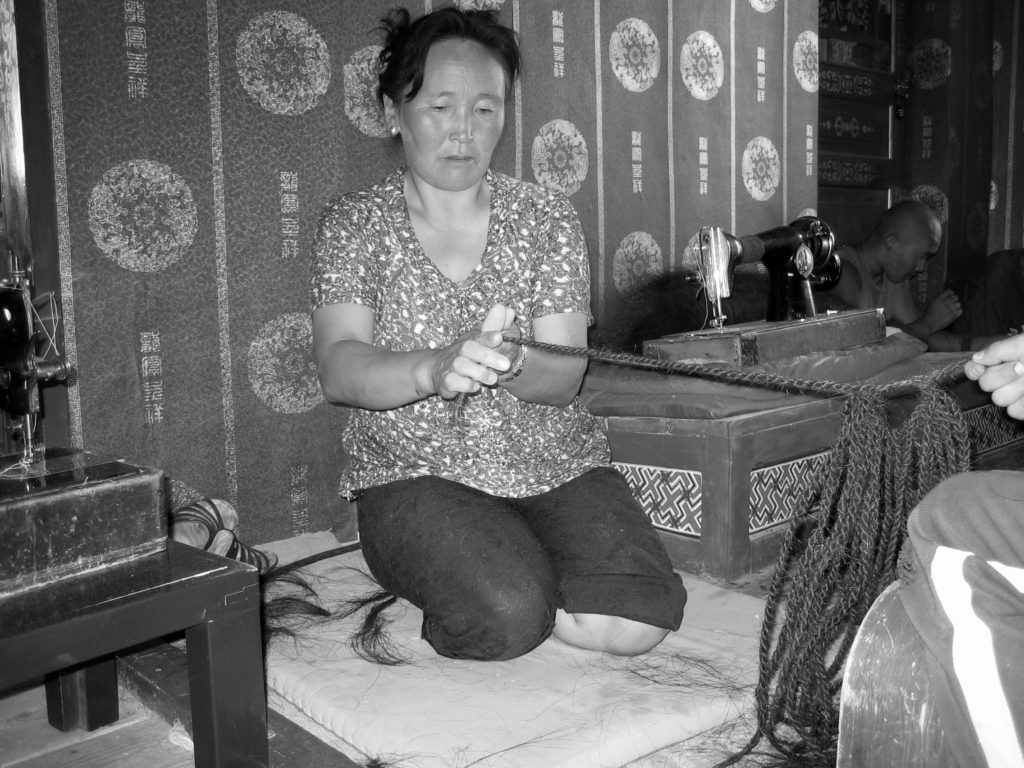
Monkhtsetseg worked with focus, speed and precision during the hours she spent rolling and plaiting by hand lustrous horse mane hair (never from the tail) into lengths of rope that still connect trellises supporting the surrounding wall of the Shining White Palace Ger-Gompa at DC. This was one of her contributions to the collaborative rebuilding effort. Once cut, the horses’ hair had been meticulously cleaned, teased out and separated into smaller workable lots. The young lams, women and men all pitched in to do this very time-consuming preparatory work together. In many respects, during this early phase of reconstruction (2004-6) the emphasis was on ‘local’ ‘quality’ ‘traditional’ and ‘hand-made’ artisan craft. The joy of shared purpose and endeavour was palpable. Delgeruun Choira (DC) in the Dundgovi, Mongolia. 25 July 2005. Photograph: C.Pleteshner
Background
One of the important threads in my ethnographic interests in Mongolia since 2004 has been the contribution Khalkha Mongol women are making to revitalising their spiritual traditions after the cessation of Soviet socialism here. In terms of methodology and practice (i.e., how I’ve gone about this from a non-nativist perspective) my 2017 post Vignette 06: What’s in a name? is indicative of my approach.
Recently I have been asked to write about the qualitative research framework that I settled on (and the logic underpinning it) for my study of Mongol women’s endeavours in Mongolia towards this goal i.e., revitalising their spiritual traditions. In reply to this request, here is a revised PowerPoint slide presentation I prepared for a conference (now in 3 parts, see below). It outlines the requested information including that relating to both contexts and ontology.
Photographs I have taken during fieldwork in Mongolia (such as the one above), digitised scans of other images as well as composite yet simple diagramatic representations with maps and tables I have created have been incorporated into the PPoint slides. Where there is numerical/statistical data, however rubbery, I have used arrows to help focus your thoughts on a particular point even if you do not read Mongolian or Russian Cyrillic.
Technical notes
This post is optimised for concept-interested people, desktop computers and tablets. You can view each slide show (see below) by scrolling down using either your nimble digits (swiping this way and that) or dragging the the scroll bar down (right side of PPoint window) using your mouse. Also try clicking the ‘pop out’ box (top right corner of each PPoint slide show window). Doing so will whisk you away to Google Docs (an increasing presence in our scholarly universe) where each ‘slide show’ may be easier to scroll through, print or download. In recent weeks I’ve been ‘tooling around’ (Australian-speak for ‘playing with’) a heap of new plugins. Still not sure what I think about ’embedding PPoint presentations’ in my WordPress website here this way. Terrific on-screen image quality/utility to file size/time required, but depending on the speed of your Internet connection, the slide shows can ‘feel’ a little slow to open and load. Further homework/investigation on my part is required. In terms of using ICTs, there has never been a shortage of new things to learn since I started publishing CPinMongolia.com in the public domain back in 2014.
More notes
Each PowerPoint slide presents an aspect of this Mongolian women-in-Mongolia research project. There are around 30 slides in total. Due to FTP upload limitations (best to keep each file under 5MB) I have divided one quite long instructional slide show (13MB) into 3 smaller parts. Not every aspect of my framework i covered in detail but its a good start for those of you new to my approach. In terms of appearance, some slides may seem visually and conceptually dense (to some readers), possibly fragmented and ‘messy’. Some Mongolian friends have suggested (in good humour) that such an appearance is not dissimilar to post-socialist life in Mongolia itself. And others, such as auto-ethnographers and their construction of ethnographic texts, for sure, argue that life is messy, emotional and uncertain too (a nod to advocates of ‘messy’ ethnography) especially when one is wading around in experimental waters so as to materialise in narrative form well-researched yet innovative ethnographic texts (a nod to G.E. Marcus).
PART 1
 Loading...
Loading...
PART 2
 Loading...
Loading...
PART 3
 Loading...
Loading...
2019 Women in Buddhism Conference
Today is the start of the international 16th Sakyadhita Conference on Women in Buddhism in Australia. I have uploaded this ethnographic research-related article and its PowerPoint presentations to my blog in celebration of this community-of-practice event.
This article Landscape 08: Women and Re-place-ing Mongolian Buddhism was researched and written by Catherine Pleteshner.
Attribution
In keeping with ethical scholarly research and publishing practices and the Creative Commons Attribution 4.0 International License, I anticipate that anyone replicating the images or translating into another language all or part of this article and submitting it for accreditation or other purpose under their own name, to acknowledge this URL and its author as the source. Not to do so, is contrary to the ethical principles of the Creative Commons license as it applies to the public domain.
end of transcript.
Refer to the INDEX for other articles that may be of interest.
© 2013-2024. CP in Mongolia. This post Landscape 08: Women and Re-place-ing Mongolian Buddhism is licensed under the Creative Commons Attribution 4.0 International License. Documents embedded or linked from this page may be subject to other restrictions. Posted: 24 June 2019. Last updated: 20 June 2022.